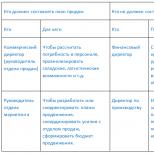An example of a real investment project with calculations
Let's consider an example of an investment project with calculations. To determine the profitability of an investment project, we will calculate the internal rate of return (IRR). To do this, first of all, you should conduct a marketing analysis and correctly assess the income that the investment project can bring.
Checkpoints are automated lockers where online stores and courier services deliver goods and parcels to customers. In the developed countries of Europe, they are used by 30-35% of Internet shoppers. We will try to calculate how profitable it is to develop this business in Russia using the example of a real and working investment project.
POST marketing
According to international statistics, 35–45% of people who make regular purchases via the Internet use check-in terminals in the United States; in Germany, respectively - 30–35%; in the Baltic countries - 20-25%. It should be borne in mind that in developed countries, the purchase of goods and services through the network is commonplace. In Russia, according to the analytical agency Markswebb, only 14% of buyers order goods online. Of this number, only 2–3% prefer to pick up purchases through the checkpoint terminals, according to the largest domestic online store Ozon.ru. True, according to the "Interesting Gifts" store, about half of the users prefer this method of receiving goods. On average, this figure hovers around 10%.
Thus, for our example With calculations, we can conclude that at the moment the demand for postamates in Russia is no more than 0.14 x 0.1 = 1.4% of the country's population. Nevertheless, the potential of the Internet market is so enormous that the Teleport company began to implement an investment project in St. Petersburg to introduce checkpoints. The essence of the project is checkpoints for every house. There are PickPoint, InPost and some other checkpoint chains in St. Petersburg, but all of them are located in large business centers, supermarkets, near metro stations, etc. This does not remove the main problem - the client still needs to go or go to get the goods and therefore prefers courier delivery or pick-up points. If there is a checkpoint right at their entrance, residents receive a service - they no longer need to go anywhere and wait for a courier. When the parcel is put into the cell, the customer receives an SMS message and he can pick up his "treasure" at any time of the day or night.
According to Evgeny Konovalov, General Director of Teleport, it will even be possible to take laundry to dry cleaning through the “slipper” accessibility checkpoints (a term introduced by this company). Therefore, the demand for them will certainly be higher - up to 40% of the total number of orders via the Internet.
The demand for Internet services in large cities is much wider than the national average and, according to statistics, amounts to 32%. However, in the calculations it is necessary to take into account one very important point, namely, it is necessary to count not by people, but by families, since if there are “young people” in the family up to 45 years old, then, despite the presence of grandmothers who do not use the Internet and do not get In the related statistics, the family as a whole is considered a potential Internet customer. According to Rosstat, 24% of pensioners live alone and, therefore, 76% of families in large cities can be considered Internet users. Of this number, full-fledged families, where two or more people can use the Internet, account for approximately 70%. The probability that a “full-fledged” family will order something via the Internet is 1 - (1 - 0.32) x (1 - 0.32) = 54%. The indicator is calculated as follows: the probability that one person buys something via the Internet = 0.32 (see above), therefore, the probability that he does not purchase anything via the Internet = 1 - 0.32 = 0.68. Therefore, the joint probability that neither one nor the other will gain anything = 0.68 x 0.68 = 0.46. Therefore, the inverse probability that at least one of the two will buy something via the Internet = 1 - 0.46 = 0.54, i.e. 54%.
Accordingly, in our example with calculations, the number of families potentially carrying out orders via the Internet is 0.76 x (0.7 x 0.54 + 0.3 x 0.32) = 36%. We calculated this figure as follows. 70% of families using the Internet are families where two or more people use the Internet and, as we calculated earlier, the probability that at least one of the two uses the Internet is 54%. Therefore, they account for = 0.7 x 0.54 = 37.8% - purchases on the Internet. 30% are “single” families, where only one person uses the Internet with a probability of 0.32 (see above), i.e. single families give us 0.3 x 0.32 = 9.6% - online buyers. Together, this = 37.8 + 9.6 = 47.4% are bought via the Internet by families that use the Internet. And since “young” families using the Internet are 76%, the total percentage of apartments buying something on the Internet = 0.76 x 0.474 = 36%.
So far, the company has installed 30 pilot checkpoints in a residential area. One new building has 200-300 sq. This means that about 300 x 0.36 = 108 households in one house can be potential clients. Of these, 40% will prefer postamat to couriers (see above), i.e. there are 108 x 0.4 = 43 families per one that can use it. According to statistics, families making purchases on the Internet do this with a frequency of 3-4 times a month. Accordingly, one house has an average of 43 x 4 = 172 purchases per month. Under contracts with online stores, the holder of the parcel terminals receives 70–140 rubles. for each use of the cell. Accordingly, the gross revenue from one of them is 172 x 140 = 24,080 rubles (rounded up to 24,000 rubles) (On average, one house will use a parcel terminal within a month 172 times, for each use 150 rubles). See also, .
Download useful documents
Calculation of costs in the example of an investment project
The biggest expense item in this investment project is the postamat itself. Their purchase price is from 250,000 rubles. up to 1.5 million rubles. for a unit. Teleport manufactures cameras itself and costs 150,000 rubles.
The second item of expenses is the rent for the installation of checkpoints at the entrances. Presumably, renting one camera will cost 5,000-10,000 rubles. officially, or 2000-3000 rubles. cash in your pocket.
Plus to this you need to add the salary of the employees. At the moment, Teleport employs 8 people and serves 30 post offices, based on the average salary - this is 10,000 rubles. for everyone. However, another 150-180 new cameras will be installed in the next six months.
Thus, office salaries will be allocated to the total number of post offices and will be, taking into account deductions from for a salary to the state in the amount of 30% somewhere: 8 (people) x 40,000 (employee's salary per month) x 1.3 (deductions to the payroll) / 180 (number of postamats) = 2300 rubles. for one.
At the same time, it should be taken into account that when covering each new district, Teleport will open a new sorting point there, without which the parcel terminal services will lose some of their attractiveness for online stores. Indeed, before their installation, couriers had to travel to each remote address, and now suppliers can immediately take all orders to the sorting point. But this means renting a warehouse, the work of storekeepers and the company's own couriers, delivering products from the sorting point to the address. To service 30 checkpoints, it is enough to rent a warehouse of 30 sq. m and hire one sorter and two couriers. Based on the rent of $ 5 / sq. M. and the salary of the sorter and couriers in 30,000 rubles, we get:
- 30 sq. m rent for $ 5 at the rate of 64 rubles = 9600 - rent for a warehouse;
- salary of couriers and storekeeper - 30,000 rubles x 3 = 90,000 rubles;
- taxes and payments are charged on salary in the amount of 30% - total 9000 x 1.3 = 117000 rubles.
- 9600 + 117000 = 126,600 rubles. one sorting point.
One point serves 30 checkpoints, i.e. 126000/30 = 4200 rubles. cost per one.
For current repairs and maintenance of each of them, the company pledges 500-1000 rubles. per month
Total costs for one checkpoint are on average 3000 (rent) + 2300 (salary office) + 4200 (warehouse) + 500 (repair) = 10000 rubles. per month.
The service life is calculated for 20 years. However, investors want to "recoup" the invested funds in no more than 5 years, i.e. depreciation of one postamat is 150,000 rubles. / 60 months = 2500 rubles.
Thus, the total costs for one postamat are 10,000 + 2,500 = 12,500 rubles. and the gross profit, respectively, is 24,000 - 12,500 = 11,500 per month (revenue - costs). Taking into account income tax of 20%, this is 9,200 rubles. per month from one checkpoint.
Financial flows and payback period
According to our conditions, Teleport must install 180 automatic checkpoints in six months, i.e. 30 per month. At the same time, we remember that one sorting point is opened for each series of parcel terminals. Further expansion of the network is not carried out at the expense of initial investment funds and is not being considered (everything is the same there).
When calculating (table 1) it is necessary to take into account that the investor buys postamates, which will not pay off soon, but in cost price he only lays down their depreciation, i.e. in spite of the fact that the project has not yet paid off and does not bring actual profit, according to accounting it already pays profit tax.
Table 1. Investment period financial flows
|
Payment |
P. No. |
Postamates |
1 month |
2 months |
3 months |
4 months |
5 months |
6 months |
Investment |
|
Number of postamats |
|||||||||
|
General expenses |
5 216 000 |
5 516 000 |
5 816 000 |
6 116 000 |
6 416 000 |
6 716 000 |
35 796 000 |
||
|
Postamates |
|||||||||
|
Running costs |
1 016 000 |
1 316 000 |
1 616 000 |
1 916 000 |
2 216 000 |
8 796 000 |
|||
|
Postamat repair |
|||||||||
|
Income tax |
|||||||||
|
Revenue |
1 440 000 |
2 160 000 |
2 880 000 |
3 600 000 |
4 320 000 |
15 120 000 |
|||
|
Current profit |
1 264 000 |
1 684 000 |
2 104 000 |
6 324 000 |
|||||
|
Total profit |
-4 496 000 |
-4 076 000 |
-3 656 000 |
-3 236 000 |
-2 816 000 |
-2 396 000 |
-20 676 000 |
The investor buys postamates and receives a certain income from them, from which he pays salaries, rent, etc., and again directs the remaining funds to the purchase. Thus, the amount of reinvestment is equal to the difference between revenue and current costs. In our case, this is 6,324,000 rubles. In this case, the amount of investment is all expenses minus the amount of reinvestment, i.e. 35,796,000 - 6,324,000 = 29,472,000 rubles. In other words, to incur expenses in the amount of 35.8 million rubles. the investor needed to invest only 29.4 million rubles, and the remaining 6.3 million rubles. appeared as a result of the project. Thus, with rounding off, the investment amount was - RUB 30 million
After the investment period, when 180 postamats have already been purchased, the total costs will be equal to the current ones. Table 2 shows financial flows for 5 years. Investment period data and one month values are taken from Table 1 (marked with the appropriate color). Data for half a year and a year were obtained by multiplying monthly by 6 and 12 months.
For the first six months of investment discounting no, because this period is considered zero. After 5 years, the cost of the postamat itself must be added to the financial results, since they don't disappear anywhere. Roughly speaking, if at the end of the project the investor decides to sell them, then there will be another inflow equal to the cost of postamats.
Table 2. Financial flows over 5 years
|
Postamates |
Per month |
Investment period |
Costs and revenues for the II half of the year |
Revenue, costs and profit for 2 years |
Revenue, costs and profit for 3 years |
Revenue, costs and profit for 4 years |
Revenue, costs and profit for the 5th year |
Postamates |
Total |
|
Revenue |
|||||||||
|
Costs |
|||||||||
|
Total profit |
-20 676 000 |
119 940 000 |
Table 2 shows that the payback period for the project is already 2 years.
Calculation of the internal rate of return (IRR) for an investment project
The simple ROI of this investment is calculated as a profit-to-cost ratio of 9200/12500 = 73.6%. This is a very high rate of return, however, it is necessary to take into account the risks in the implementation of an investment project, the likelihood of earning income and correlate all this with a risk-free rate of return. In addition, it is necessary to discount cash flows, i.e. bring the value of future money to the present moment.
In order to determine the current cost of the project NPV (Net present value), it is necessary to determine the discount rate - "R" ( ). The discount rate is the rate of return that the investor wants to receive as a result of the investment project. There is a very complex and time-consuming methodology for calculating the "R" WACC, which is used mainly in the West for joint-stock companies, where annual statistical compilations with the necessary data are printed. In our example of an investment project with calculations, a non-joint-stock company is considered and there is no statistics for this project, since this is a startup that has no analogues in St. Petersburg yet.
In practice, the expert method is usually used, according to which the risk premium is added to the risk-free rate of return. Investments in federal loan bonds "OFZ" are considered risk-free. According to the MICEX data on OFZ 2016, the coupon yield with maturity in 5 years is 11%. That is, the risk-free rate R - we can take it as 11%
The main risks of a start-up with checkpoints are, firstly, the threat that existing players in this market, such as PickPoint, will quickly begin to develop this niche, since checkpoints in front doors make them unnecessary in supermarkets - this is a direct threat to their business. However, the capacity of the St. Petersburg market is quite enough for a project for 180 postamat stations, so this danger can be estimated at no more than 20%. Further expansion of the project and its attractiveness for the investor are being questioned.
The second danger is that a much smaller number of apartments will use checkpoint services. The probability of this exists, since all issues can be resolved with a courier directly on the spot, but not with iron boxes. I would estimate the probability of this risk at 30%.
Other threats can be cumulatively estimated at another 30%
Formula calculating the risk rate in our case may look like this:
Rr = R / Ver, i.e. the primary rate must be increased as many times as the risks and threats reduce the likelihood of project implementation.
R is the risk-free rate, which we have taken for the interest given on OFZ bonds.
In our example of an investment project: Rr = 11 / ((1 - 0.2) x (1 - 0.3) x (1 - 0.3)) = 28.1% The method I proposed is subjective in the same way as any other "expert opinion". Thus, we will accept the discount rate - 28%
PaymentNPV is carried out according to the formula:

where D is cash flow;
Rr - discount rate;
n is the number of years.
Table 3... NPV calculation
|
Postamates |
Invest |
II floor |
2 year |
3 year |
4 year |
5 year |
Postamates |
Total |
|
Revenue |
||||||||
|
Costs |
||||||||
|
Total profit |
||||||||
|
Discounted |
SUM (D27: J27) |
|||||||
|
Discounted |
41 247 623 |
Thus, NPV = 41,247,623 rubles. (41 million rubles). NPV is positive and significantly exceeds the initial investment of RUB 30 million, i.e. this investment project is promising.
How promising is the calculation internal rate of return IRR... This indicator shows how many times the discounted income exceeds the initial investment. If the IRR is greater than Rr, then this project can be dealt with.
In general terms, the IRR formula looks like this:

To find this indicator mathematically, it is necessary to solve a complex equation of the n-th degree, therefore, in practice, Excel uses the internal IRR formula (internal rate of return), which is located in the "finance" category (see Figure 1).
Picture 1... Calculating IRR in Ecxel
![]()
Note: in the fifth year, the cost of the postamates themselves is added to the amount of profit.
So, the IRR turned out to be equal to 92.7%, which is much more than the discount rate, i.e. the project is profitable, promising and cost-effective.
In conclusion, we note that for a new type of startup business in a growing market, the market share that the new business will capture is much more important than the profitability of the project. At first, it is especially important for an enterprise to enter the market and consolidate its strong positions, therefore, when evaluating an investment project, the market share indicator is more important than IRR.





